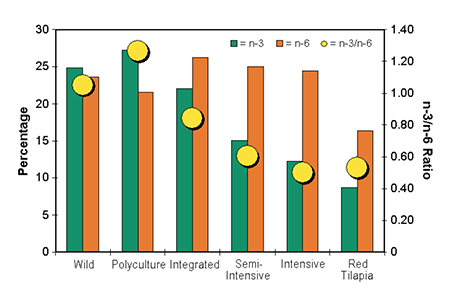Evaluation conducted by University of Stirling, Asian Institute of Technology

An improved understanding of the differences in lipid profiles that occur in fish from wild stocks and those farmed across the spectrum of intensity should help inform the debate about food production strategies. This is particularly important in developing countries, where poor people are most dependent on fish in their diets and pressures for intensification of aquaculture are growing.
The authors recently examined the fatty acids from tilapia from a range of aquaculture systems in Thailand to determine the abundance of omega-3 and omega-6 polyunsaturated fatty acids (PUFA) in order to optimize the omega-3:omega-6 ratio for human nutrition.
Fish and fatty acids
Fish have provided a nutritious and readily available source of food throughout human history. Traditionally, fish were thought of mainly as a source of high-value protein. More recently, especially in western societies, it is increasingly appreciated that the long-chain omega-3 PUFA abundant in fish are important dietary components.
DHA and EPA
Docosahexaenoic acid (DHA, 22:6 omega-3) is essential for correct neural development and function. Conversely, dietary excess of omega-6 PUFA, which leads to elevated levels of arachidonic acid (AA, 20:4 omega-6) and proinflammatory eicosanoids, is a major factor in the increased incidence of circulatory and inflammatory disorders in populations who consume “western” diets. Eicosapentaenoic acid (EPA, 20:5 omega-3) in fish and fish oils can counter the proinflammatory omega-6 metabolites.
Balance important
It has been argued that early Homo inhabiting lake and river regions were only able to evolve large brains because of the readily available supply of fish, which provided both the DHA required for neural membranes and AA for brain vasculature in the correct ratios and amounts. Our knowledge of lipid nutrition, therefore, concludes that it is not only the amount of PUFA, but also the balance between omega-3 and omega-6 fatty acids that is important for a healthy diet. Human diets high in seed oils rich in 18:2 omega-6 (which ignore our evolutionary roots), can cause problems.
Lipid origin
The healthful effects of long-chain omega-3 PUFA are generally accredited to oils from marine species of fish, but the lipids from freshwater species also serve as a valuable source of essential fatty acids. Compared with marine fish species, freshwater fish generally contain higher levels of saturates and 18 carbon PUFA, but nonetheless contain substantial concentrations of EPA and DHA.
In addition, freshwater fish are of interest because they have a greater capacity than marine fish to elongate and desaturate the 18 carbon PUFA synthesized by algae or plants into EPA and DHA. Thus, the omega-3: omega-6 ratio and total fatty acid content are good criteria for the fat quality of the fish and a reflection of what the fish ate. A balanced omega-3:omega-6 ratio is important both for rearing healthy fish and producing a valuable food for humans.
Study
In our recent study, the fatty acid contents and compositions of Oreochromis niloticus tilapia and hybrid red tilapia in Thailand were determined. Batches of fish were taken from culture systems ranging from extensive, where fish fed mainly on natural food, to intensive systems that used artificial feeds. Fish from the wild were also examined.
Karapanagiotidis, Fatty acid composition (weight %) of flesh samples from tilapia, Table 1
| Fatty Acid | Wild Fish | Extensive Polyculture | Integrated With Chicken Farming | Semi-Intensive Pond Culture With Pellets, Chemical Fertilizer | Intensive Pond Culture Feeding Only Pellets | Red Tilapia Cage Culture Feeding Only Pellets |
|---|
Fatty Acid | Wild Fish | Extensive Polyculture | Integrated With Chicken Farming | Semi-Intensive Pond Culture With Pellets, Chemical Fertilizer | Intensive Pond Culture Feeding Only Pellets | Red Tilapia Cage Culture Feeding Only Pellets |
|---|---|---|---|---|---|---|
| 18:2n-6 | 6.2 | 7.0 | 12.1 | 9.5 | 14.0 | 11.1 |
| 18:3n-3 | 3.9 | 3.3 | 1.1 | 0.8 | 1.2 | 0.7 |
| 20:4n-6 | 8.9 | 7.8 | 6.9 | 7.6 | 3.1 | 1.7 |
| 20:5n-3 | 2.1 | 3.0 | 1.7 | 1.4 | 0.4 | 0.3 |
| 22:6n-3 | 11.1 | 14.7 | 14.2 | 9.9 | 8.6 | 5.9 |
| n-3/n-6 ratio | 1.1 | 1.3 | 0.8 | 0.6 | 0.5 | 0.5 |
Results

The results showed variable amounts of C18, C20 and C22 PUFA of both the omega-3 and omega-6 series (Fig. 1) and consequent differing omega-3:omega-6 ratios of 0.5 to 1.3 in the muscle tissues of the fish (Table 1).
The higher ratios came from the wild fish and fish that relied on natural food. Moreover, wild fish and fish reared under extensive conditions also showed higher proportions of C20 and C22 PUFA (i.e., EPA and DHA) relative to their C18 PUFA homologues (mainly 18:2 omega-6) in the total fatty acid composition. They thus showed the highest lipid nutritive value for human nutrition.
Conclusion
A study found it was impossible to define a “standard” tilapia in terms of fatty acid composition. The vegetable meals and oils that contained omega-6 fatty acids in the diets of farmed fish caused a higher deposition of 18:2 omega-6 in the fish.
It is recommended that the amount of 18:2 omega-6 in the fish diets be reduced by substituting with vegetable oils and meals rich in 18:1 omega-9 and/or 18:3 omega-3, in order to maintain the correct omega-3:omega-6 ratio and enhance the levels of DHA for human nutrition.
(Editor’s Note: This article was originally published in the December 2002 print edition of the Global Aquaculture Advocate.)
Now that you've finished reading the article ...
… we hope you’ll consider supporting our mission to document the evolution of the global aquaculture industry and share our vast network of contributors’ expansive knowledge every week.
By becoming a Global Seafood Alliance member, you’re ensuring that all of the pre-competitive work we do through member benefits, resources and events can continue. Individual membership costs just $50 a year. GSA individual and corporate members receive complimentary access to a series of GOAL virtual events beginning in April. Join now.
Not a GSA member? Join us.
Authors
-
Ioannis T. Karapanagiotidis, MSc.
Institute of Aquaculture
University of Stirling
Stirling FK9 4LA
United Kingdom -
Michael V. Bell, Ph.D.
Institute of Aquaculture
University of Stirling
Stirling FK9 4LA
United Kingdom -
Amararatne Yakupitiyage, Ph.D.
AARM, SERD
Asian Institute of Technology
Pathumthani, Thailand
Related Posts

Health & Welfare
Amino acid supplementation reduces protein levels in pangasius diets
Trials show that supplementation with amino acids could reduce protein levels from a typical 28 percent to 23 percent in pangasius diets.

Innovation & Investment
At GOAL, a peek at potential aquaculture futures
At the Global Aquaculture Alliance’s annual GOAL conference in Guyaquil, Ecuador, unfamiliar topics gave aquaculture industry leaders something to chew on.

Responsibility
Biofloc technology options for aquaculture
Biofloc technology offers advantages for the sustainable culture of shrimp and some species of fish.

Health & Welfare
Brazilian researchers examine amino acids in Nile tilapia diets
Determining dietary requirements for tilapia requires precise formulation. Individual amino acids must be considered to establish well-balanced diets.


